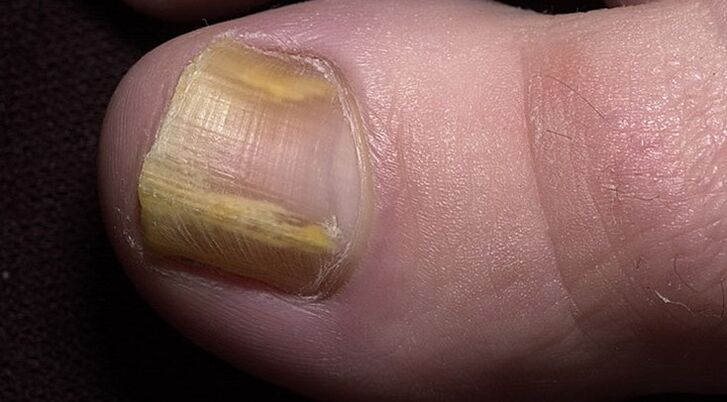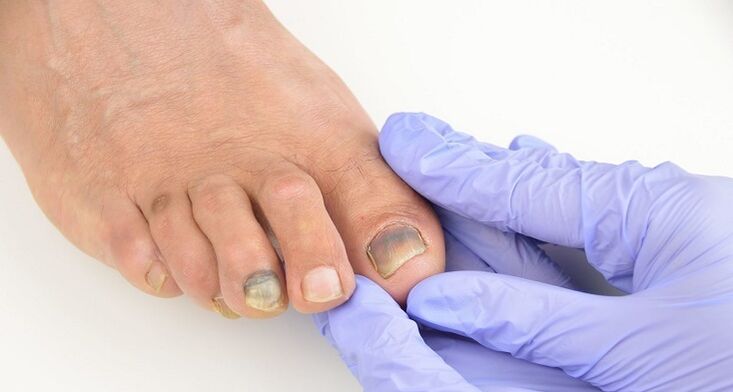Nail fungus is a disease caused by various groups of pathogens. To destroy it, you will need to undergo diagnostics to identify all the features of the disease. What are the causes of its occurrence? There are many reasons for the appearance of a fungal infection, the prerequisites for its appearance.

Genetic causes of the disease
Fungal spores can be found on various surfaces for years. A person often encounters pathogenic microorganisms, but infection does not always occur. In order for nail fungus to appear, there must be accommodating factors. The infection must have the conditions for development. Scientists have done a lot of research on the mechanism of disease onset.
It turned out that one of the factors in the appearance of a fungal infection is a genetic predisposition. According to research, mycosis occurs more often in people whose relatives have a similar condition. The progression of the disease affects the genetic level.
Interesting cases of infection when living together. With close contact, it is easier to contract mycosis. However, it often develops in one family, but does not affect the other. And the disease usually appears in the person who has the most similar genes to the person who initially developed mycosis. According to all these data, proximity of contact is of less importance for infection than proximity of genetic links.
Symptoms of mycosis
Nail fungus manifests itself in different ways in different stages. Typically, mycosis infection begins with the interdigital spaces. Right now there is:
- The appearance of the bubbles;
- redness of the skin;
- Itch.
If the treatment is not carried out at this stage, the disease begins to affect the nails. In this case, the following signs are detected:
- Dullness of the nail plate, loss of transparency from it;
- The appearance of white streaks, spots;
- Uncomfortable sensations.
It is better to carry out the treatment at this stage, as this will reduce the cost of therapy. To destroy microorganisms, external preparations will be enough: ointments, paints. If you don't take action, the nail fungus will progress. This is expressed through the following symptoms:
- Thinning or thickening of the nail
- Exfoliation of the nail plate;
- Departure from the nail bed;
- The dish acquires an anomalous color: it becomes white, yellow or black;
- In the last stages, the nail literally crumbles, collapses and an unpleasant odor can occur.
Mycosis carries out its pathological activity not only on the toenails. Inflammatory processes occupy the entire foot.
He begins to blush, comes off. The patient experiences itching, which intensifies during periods of exacerbation. The presence of characteristic signs allows you to determine the disease at the initial examination.

Types of fungal infections
Nail fungus is divided into types depending on the group of microorganisms by which it is caused. There are three main groups:
- Dermatophytes.The most common case. This group causes mycosis in 95% of cases;
- Candida.These yeast-like microorganisms contribute to the thinning of the nail plate. It begins to yellow and lags behind the bed. The injury begins with the nail fold. With the development of the disease, swelling occurs. In some cases, pus discharge may occur. The skin of the plate stops growing and then turns brown. The nail is crumbling. These groups of microorganisms usually develop in women. There are risk groups: housewives who constantly deal with household chemicals. It aggressively affects the skin, which opens the "doors" to infections;
- Moldy species.These groups of microorganisms cannot penetrate deep into the nail plate. This does not allow to completely destroy it, but the disease is fraught with other effects. The nail changes a lot of color. It can take on a black, blue, green hue.
Treatment is carried out according to the group of microorganisms, since different pathogenic microbes react differently to drugs. Sometimes, when diagnosed, three types of fungi are detected. In this case, complex therapy will be required.
Forms of mushrooms
There are various stages of the disease, which differ in the type of lesions:
- normotrophic.The color of the nail plate changes. It can turn yellow, lose transparency. White and yellow streaks or dots appear. The difference between the disease is that the nail does not undergo significant deformation. Sometimes it can even retain its former glory;
- atrophic.The nail becomes thinner, completely loses its luster. There are pronounced white and yellow stripes, spots that represent special foci of infection;
- Hypertrophic.The dish changes considerably. Thickening, signs of crumbling are observed. It becomes porous. A pronounced pain syndrome is also possible, aggravated during movement, wearing tight shoes. The disease can limit a person's activity.
The treatment regimen prescribed depends on the stage and type of microorganisms. In the early stages, external agents proved effective. In the later stages, the treatment regimen is usually a combination of topical and oral medications.
Where can you get a mushroom?
Nail fungus is usually spread from person to person. Spores of microorganisms can remain on surfaces. When you touch them, the fungus will stay on your feet and start developing. You can catch mycosis in the following places:
- Public institutions: saunas, swimming pools, sports club showers. This is the most likely way to get the fungus, as it multiplies most actively in hot, humid conditions. To protect yourself, it is necessary, before going to the institution, to carry out preventive treatment of the feet with drugs. You must have your slippers with you;
- If mycosis occurs in one family, a probable pathway for the onset of the disease in other family members is to take a bath. The spores of the fungus remain on its walls, causing mycosis. For protection, surfaces should be treated with disinfectants after each visit to the bathroom;
- Sometimes the reason is a manicure or pedicure performed with tools that have not been disinfected since the last use. This refers to the procedures performed in beauty salons;
- Disputes can be lurking in the store's shoes, as they are often tried on by different people. For protection, you can only measure shoes on the toe;
- A less likely source of infection is public beaches, as nail fungus does not survive well in the salty sand.
To prevent the disease, one should not forget the importance of personal slippers and use prophylactic means.

Possible complications with prolonged treatment
For mycosis, the rate of development and spread is characteristic. If you are late in treatment, the symptoms of the disease will become more and more pronounced. At first, a person is worried about the aesthetic factor, as thickening, white dots appear on the toenails. But if you don't fight the problem, more serious consequences will come - pain when moving, itching and burning. Let's consider the most likely consequences of prolonged treatment:
- Other infections are likely when the body weakens;
- Exacerbation of diabetes mellitus. The occurrence, against the background of an infectious process, gangrene or infection of the bone tissue. All this can lead to the need for limb amputation;
- If the nail fungus is not treated for a long time, the body can react to it with hypersensitivity and allergic reactions. Against the background, allergic dermatitis, skin diseases, bronchial asthma are aggravated;
- The extreme stage of mycosis is damage to internal organs. The infection begins to spread throughout the body. This can be fatal.
Another important consequence of not starting therapy on time is the significant financial costs. In the later stages, the disease is not only more difficult to treat, but also more expensive. We will have to spend money on local procedures, pills. Truly effective drugs are more expensive. In some cases, surgery may also be prescribed.
Preventive measures
Nail fungus can be prevented, which is what preventative measures are aimed at. They allow you to prevent the entry of a pathogenic microorganism and its further spread. Prevention is quite simple and consists in observing the following tips:
- Elimination of narrow shoes, wrongly chosen last. All this leads to the appearance of corns and other deformations through which the infection penetrates inside;
- Avoid wearing synthetic socks and tights because your feet sweat. Sweat and a humid environment are the best conditions for the growth of the fungus;
- It is necessary to observe personal hygiene, wear slippers in indoor public places, carry out preliminary treatment of the feet with prophylactic agents;
- After each washing of the feet, the interdigital areas are carefully dried;
- Replacement of socks and stockings should be done every day;
- You can't wear someone else's shoes;
- The house must be kept clean, for which periodic disinfection is carried out.
Prevention has two objectives: to prevent the infection from entering and to stop its development if the spores can enter. To achieve the second goal, you will need to take care of your immune system: play sports, eat well.
Methods of treatment
Nail fungus usually takes a long time to heal. The duration of therapy, regardless of the cause of the disease, will be from 6 months to a year. The benefit is that most medications can manage symptoms quickly. But, despite the disappearance of symptoms, it is necessary to continue therapy until the complete destruction of microorganisms.
For treatment in the early stages, external drugs are used. These include:
- Special paints;
- Creams and gels;
- Solutions and tinctures.
In the later stages, oral drugs are added to external drugs:
- Pills;
- Antibiotics
Paints are especially popular. They have two effects at once: they destroy existing microorganisms and create a film that prevents the entry of new infections. The tool is able to penetrate deep into the nail. It is colorless and odorless and therefore can be used by men. It is recommended to remove the nail plate before use to ensure deeper penetration.

Ointments and gels are gentle. They are easy to use. Quickly relieves symptoms. With the help of medicines, you can treat not only the nails, but also the skin around them. The downside is that the product can quickly wear away from the skin. To avoid this, compresses can be performed: a cotton swab is placed on top of the ointment layer, fixed with a bandage.
Tablets are prescribed in severe cases. This remedy has a strong effect, is toxic and has contraindications. For this reason, therapy is carried out under the supervision of a doctor.
If the case is completely neglected, surgery comes to the rescue. During the operation, the affected nail is removed. Its removal can be done without surgery. For this, special means are used. The last option is painless.
Nail fungus is an extremely common problem. Its pitfall lies in the fact that, in the early stages, the signs of the disease are insignificant. The patient can constantly postpone treatment, as he does not feel discomfort. All this leads to the fact that the problem is overlooked. To fix it, you will need a lot of funds and medicines. Mycosis spreads rapidly, causing pain, plaque detachment, unpleasant odors, and nail changes.















